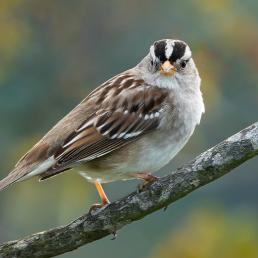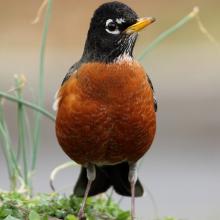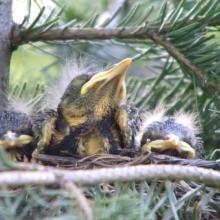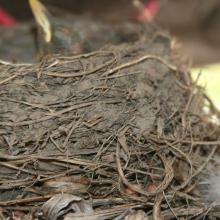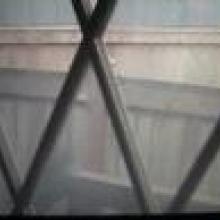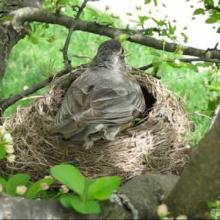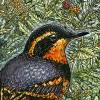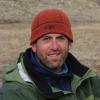

Join BirdNote tomorrow, November 30th!
Illustrator David Sibley and actor H. Jon Benjamin will face off in the bird illustration battle of the century during BirdNote's Year-end Celebration and Auction!
When glaciers pushed south into what is now the U.S. around 20,000 years ago, they scraped off the soil layer and spelled the end of native earthworms except in the southern states. So the earthworm plucked by the robin in the park or on your lawn is probably a relatively new arrival, most likely a species Europeans conveyed to the Americas in plant soil or the ballast of ships.
BirdNote®
Robins and Earthworms: The Backstory
Written by Bob Sundstrom
This is BirdNote.
[American Robin song, http://macaulaylibrary.org/audio/168300, 0.7-.11 Wil Hershberger]
A robin tugging an earthworm from the ground is a symbol of spring. But that worm it’s eating hasn’t always been here.
When glaciers pushed south into what is now the U.S. around 20,000 years ago, they scraped off the soil layer and spelled the end of native earthworms except in the southern states. So that earthworm plucked by the robin is probably a relatively new arrival, most likely a species Europeans conveyed to the Americas in plant soil or in the ballast of ships.
So if not earthworms, what were robins feeding their chicks before Europeans arrived? Well, probably some of the more than a hundred kinds of insects and other invertebrates, as well as berries, that robins are known to eat.
[American Robin song, http://macaulaylibrary.org/audio/168300, 0.7-.11 Wil Hershberger]
Robins prefer to forage in short grass to avoid potential predators. But after the last ice sheets melted back, where was the short grass they liked? One speculation is that prehistoric bison, horses and mammoths grazed heavily in places, creating robin-friendly landscapes.
[American Robin call, http://macaulaylibrary.org/audio/133356, 0.41-.45 Geoffrey A. Keller]
Just as robins now share pastures with cows, perhaps 15,000 years ago they hopped among giant bison or woolly mammoths.
[American Robin call, https://macaulaylibrary.org/asset/165508871#_ga=2.127328004.881227614.1…, 0.09-.10 Bruce Rideout]
It’s fun to picture, at least.
For BirdNote, I’m Mary McCann.
###
Senior Producer: Mark Bramhill
Producer: Sam Johnson
Managing Editor: Jazzi Johnson
Content Director: Jonese Franklin
Bird sounds provided by The Macaulay Library of Natural Sounds at the Cornell Lab of Ornithology, Ithaca, New York. Recorded by Wil Hershberger, Geoffrey A. Keller, and Bruce Rideout
BirdNote’s theme was composed and played by Nancy Rumbel and John Kessler.
© 2020 BirdNote May 2020 March 2023 / 2025
Narrator: Mary McCann
ID# AMRO-17-2020-5-5
http://www.indefenseofplants.com/blog/2017/5/3/invasion-of-the-earthwor…
https://ask.extension.org/questions/231134
https://markgelbart.wordpress.com/tag/genetic-evidence-of-robin-evoluti…
https://sora.unm.edu/sites/default/files/journals/auk/v103n04/p0710-p07…
